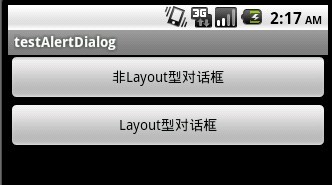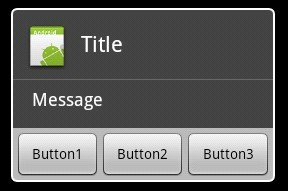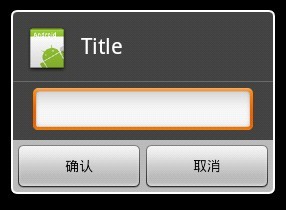Android入门之AlertDialog
2014-11-18 15:31
489 查看
本文来自http://blog.csdn.net/hellogv/ ,引用必须注明出处!
时隔一年,又要准备做Android的开发了,最近复习和整理一下Android的知识。这次要说的是AlertDialog,这种对话框会经常遇到。AlertDialog跟WIN32开发中的Dialog不一样,AlertDialog是非阻塞的,而阻塞的对话框用的是PopupWindow。
先贴出程序运行的截图:

main.xml的源码:
[xhtml] view
plaincopyprint?
<?xml version="1.0" encoding="utf-8"?>
<LinearLayout xmlns:android="http://schemas.android.com/apk/res/android"
android:orientation="vertical"
android:layout_width="fill_parent"
android:layout_height="fill_parent"
>
<Button android:id="@+id/Button01" android:layout_height="wrap_content" android:text="非Layout型对话框" android:layout_width="fill_parent"></Button>
<Button android:id="@+id/Button02" android:layout_height="wrap_content" android:text="Layout型对话框" android:layout_width="fill_parent"></Button><View android:id="@+id/View01" android:layout_width="wrap_content" android:layout_height="wrap_content"></View>
</LinearLayout>
下图是非Layout型对话框,直接使用AlertDialog

下图是使用了Layout的对话框,可以自定义控件,实现更复杂的对话框

dialoglayout.xml的源码:
[xhtml] view
plaincopyprint?
<?xml version="1.0" encoding="utf-8"?>
<LinearLayout xmlns:android="http://schemas.android.com/apk/res/android"
android:layout_width="fill_parent" android:layout_height="wrap_content"
android:orientation="vertical">
<EditText android:layout_height="wrap_content"
android:layout_width="fill_parent" android:layout_marginLeft="20dip"
android:layout_marginRight="20dip" android:textAppearance="?android:attr/textAppearanceMedium" android:id="@+id/edtInput"/>
</LinearLayout>
程序源码:
[java] view
plaincopyprint?
package com.testAlertDialog;
import android.app.Activity;
import android.app.AlertDialog;
import android.content.Context;
import android.content.DialogInterface;
import android.os.Bundle;
import android.view.Gravity;
import android.view.LayoutInflater;
import android.view.View;
import android.view.View.OnClickListener;
import android.widget.Button;
import android.widget.EditText;
import android.widget.PopupWindow;
public class testAlertDialog extends Activity {
Button btnShowDialog;
Button btnShowDialog_Layout;
/** Called when the activity is first created. */
@Override
public void onCreate(Bundle savedInstanceState) {
super.onCreate(savedInstanceState);
setContentView(R.layout.main);
//定义按钮
btnShowDialog=(Button)this.findViewById(R.id.Button01);
btnShowDialog.setOnClickListener(new ClickEvent());
btnShowDialog_Layout=(Button)this.findViewById(R.id.Button02);
btnShowDialog_Layout.setOnClickListener(new ClickEvent());
}
//统一处理按键事件
class ClickEvent implements OnClickListener{
@Override
public void onClick(View v) {
// TODO Auto-generated method stub
if(v==btnShowDialog)
showDialog(testAlertDialog.this);
else if(v==btnShowDialog_Layout)
showDialog_Layout(testAlertDialog.this);
}
}
//显示基本的AlertDialog
private void showDialog(Context context) {
AlertDialog.Builder builder = new AlertDialog.Builder(context);
builder.setIcon(R.drawable.icon);
builder.setTitle("Title");
builder.setMessage("Message");
builder.setPositiveButton("Button1",
new DialogInterface.OnClickListener() {
public void onClick(DialogInterface dialog, int whichButton) {
setTitle("点击了对话框上的Button1");
}
});
builder.setNeutralButton("Button2",
new DialogInterface.OnClickListener() {
public void onClick(DialogInterface dialog, int whichButton) {
setTitle("点击了对话框上的Button2");
}
});
builder.setNegativeButton("Button3",
new DialogInterface.OnClickListener() {
public void onClick(DialogInterface dialog, int whichButton) {
setTitle("点击了对话框上的Button3");
}
});
builder.show();
}
//显示基于Layout的AlertDialog
private void showDialog_Layout(Context context) {
LayoutInflater inflater = LayoutInflater.from(this);
final View textEntryView = inflater.inflate(
R.layout.dialoglayout, null);
final EditText edtInput=(EditText)textEntryView.findViewById(R.id.edtInput);
final AlertDialog.Builder builder = new AlertDialog.Builder(context);
builder.setCancelable(false);
builder.setIcon(R.drawable.icon);
builder.setTitle("Title");
builder.setView(textEntryView);
builder.setPositiveButton("确认",
new DialogInterface.OnClickListener() {
public void onClick(DialogInterface dialog, int whichButton) {
setTitle(edtInput.getText());
}
});
builder.setNegativeButton("取消",
new DialogInterface.OnClickListener() {
public void onClick(DialogInterface dialog, int whichButton) {
setTitle("");
}
});
builder.show();
}
}
package com.ceac.deng;
import android.support.v7.app.ActionBarActivity;
import android.app.AlertDialog;
import android.content.DialogInterface;
import android.os.Bundle;
import android.os.SystemClock;
import android.view.Menu;
import android.view.MenuItem;
import android.view.View;
import android.view.View.OnClickListener;
import android.widget.Button;
import android.widget.Chronometer;
import android.widget.Toast;
import android.widget.Chronometer.OnChronometerTickListener;
public class MainActivity extends ActionBarActivity {
private Chronometer chronometer;
private Button stopButton;
private Button startButton;
private Button button;
private Button button2;
private Button button3;
private Button button4;
@Override
protected void onCreate(Bundle savedInstanceState) {
super.onCreate(savedInstanceState);
setContentView(R.layout.activity_main);
findView();
chronometer.setBase(SystemClock.elapsedRealtime());
// chronometer.setFormat("已经用了多少时间: %s");
chronometer.start();
chronometer.setOnChronometerTickListener(new OnChronometerTickListener() {
@Override
public void onChronometerTick(Chronometer chronometer) {
// TODO Auto-generated method stub
if (SystemClock.elapsedRealtime() - chronometer.getBase() >= 100000)
{
chronometer.stop();
}
}
});
setListenner();
}
/**
* findView
*/
private void findView()
{
chronometer = (Chronometer) findViewById(R.id.chronometer1);
stopButton = (Button) findViewById(R.id.stop);
startButton = (Button) findViewById(R.id.start);
button = (Button) findViewById(R.id.button1);
button2 = (Button) findViewById(R.id.button2);
button3 = (Button) findViewById(R.id.button3);
button4 = (Button) findViewById(R.id.button4);
}
private void setListenner()
{
stopButton.setOnClickListener(new OnClickListener() {
@Override
public void onClick(View v) {
// TODO Auto-generated method stub
chronometer.stop();
System.out.println("stop chronometer....");
}
});
startButton.setOnClickListener(new OnClickListener() {
@Override
public void onClick(View v) {
// TODO Auto-generated method stub
chronometer.setBase(SystemClock.elapsedRealtime());
chronometer.start();
System.out.println("start Chronometer....");
}
});
button.setOnClickListener(new OnClickListener() {
@Override
public void onClick(View v) {
// AlertDialog alertDialog = new AlertDialog.Builder(MainActivity.this).create();
// alertDialog.setIcon(R.drawable.ic_launcher);
// alertDialog.setTitle("系统提示");
// alertDialog.setMessage("带取消 、中立、确定按钮的对话框");
//// alertDialog.setButton(DialogInterface.BUTTON_NEGATIVE, "取消", listener);
AlertDialog.Builder builder = new AlertDialog.Builder(MainActivity.this);
builder.setIcon(R.drawable.ic_launcher);
builder.setTitle("系统提示");
builder.setMessage("带取消 、中立、确定按钮的对话框");
//确定
builder.setPositiveButton("确定", new DialogInterface.OnClickListener() {
@Override
public void onClick(DialogInterface dialog, int which) {
// TODO Auto-generated method stub
showToast("点击了确定的按钮");
}
});
//中立
builder.setNeutralButton("中立", new DialogInterface.OnClickListener() {
@Override
public void onClick(DialogInterface dialog, int which) {
// TODO Auto-generated method stub
showToast("点击了中立按钮");
}
});
//取消
builder.setNegativeButton("取消", new DialogInterface.OnClickListener() {
@Override
public void onClick(DialogInterface dialog, int which) {
// TODO Auto-generated method stub
showToast("点击了取消按钮");
}
});
builder.show();
}
});
}
/**
*
* @param str
*/
private void showToast(String str)
{
Toast.makeText(MainActivity.this, str, Toast.LENGTH_LONG).show();
}
@Override
public boolean onCreateOptionsMenu(Menu menu) {
// Inflate the menu; this adds items to the action bar if it is present.
getMenuInflater().inflate(R.menu.main, menu);
return true;
}
@Override
public boolean onOptionsItemSelected(MenuItem item) {
// Handle action bar item clicks here. The action bar will
// automatically handle clicks on the Home/Up button, so long
// as you specify a parent activity in AndroidManifest.xml.
int id = item.getItemId();
if (id == R.id.action_settings) {
return true;
}
return super.onOptionsItemSelected(item);
}
}
时隔一年,又要准备做Android的开发了,最近复习和整理一下Android的知识。这次要说的是AlertDialog,这种对话框会经常遇到。AlertDialog跟WIN32开发中的Dialog不一样,AlertDialog是非阻塞的,而阻塞的对话框用的是PopupWindow。
先贴出程序运行的截图:

main.xml的源码:
[xhtml] view
plaincopyprint?
<?xml version="1.0" encoding="utf-8"?>
<LinearLayout xmlns:android="http://schemas.android.com/apk/res/android"
android:orientation="vertical"
android:layout_width="fill_parent"
android:layout_height="fill_parent"
>
<Button android:id="@+id/Button01" android:layout_height="wrap_content" android:text="非Layout型对话框" android:layout_width="fill_parent"></Button>
<Button android:id="@+id/Button02" android:layout_height="wrap_content" android:text="Layout型对话框" android:layout_width="fill_parent"></Button><View android:id="@+id/View01" android:layout_width="wrap_content" android:layout_height="wrap_content"></View>
</LinearLayout>
下图是非Layout型对话框,直接使用AlertDialog

下图是使用了Layout的对话框,可以自定义控件,实现更复杂的对话框

dialoglayout.xml的源码:
[xhtml] view
plaincopyprint?
<?xml version="1.0" encoding="utf-8"?>
<LinearLayout xmlns:android="http://schemas.android.com/apk/res/android"
android:layout_width="fill_parent" android:layout_height="wrap_content"
android:orientation="vertical">
<EditText android:layout_height="wrap_content"
android:layout_width="fill_parent" android:layout_marginLeft="20dip"
android:layout_marginRight="20dip" android:textAppearance="?android:attr/textAppearanceMedium" android:id="@+id/edtInput"/>
</LinearLayout>
程序源码:
[java] view
plaincopyprint?
package com.testAlertDialog;
import android.app.Activity;
import android.app.AlertDialog;
import android.content.Context;
import android.content.DialogInterface;
import android.os.Bundle;
import android.view.Gravity;
import android.view.LayoutInflater;
import android.view.View;
import android.view.View.OnClickListener;
import android.widget.Button;
import android.widget.EditText;
import android.widget.PopupWindow;
public class testAlertDialog extends Activity {
Button btnShowDialog;
Button btnShowDialog_Layout;
/** Called when the activity is first created. */
@Override
public void onCreate(Bundle savedInstanceState) {
super.onCreate(savedInstanceState);
setContentView(R.layout.main);
//定义按钮
btnShowDialog=(Button)this.findViewById(R.id.Button01);
btnShowDialog.setOnClickListener(new ClickEvent());
btnShowDialog_Layout=(Button)this.findViewById(R.id.Button02);
btnShowDialog_Layout.setOnClickListener(new ClickEvent());
}
//统一处理按键事件
class ClickEvent implements OnClickListener{
@Override
public void onClick(View v) {
// TODO Auto-generated method stub
if(v==btnShowDialog)
showDialog(testAlertDialog.this);
else if(v==btnShowDialog_Layout)
showDialog_Layout(testAlertDialog.this);
}
}
//显示基本的AlertDialog
private void showDialog(Context context) {
AlertDialog.Builder builder = new AlertDialog.Builder(context);
builder.setIcon(R.drawable.icon);
builder.setTitle("Title");
builder.setMessage("Message");
builder.setPositiveButton("Button1",
new DialogInterface.OnClickListener() {
public void onClick(DialogInterface dialog, int whichButton) {
setTitle("点击了对话框上的Button1");
}
});
builder.setNeutralButton("Button2",
new DialogInterface.OnClickListener() {
public void onClick(DialogInterface dialog, int whichButton) {
setTitle("点击了对话框上的Button2");
}
});
builder.setNegativeButton("Button3",
new DialogInterface.OnClickListener() {
public void onClick(DialogInterface dialog, int whichButton) {
setTitle("点击了对话框上的Button3");
}
});
builder.show();
}
//显示基于Layout的AlertDialog
private void showDialog_Layout(Context context) {
LayoutInflater inflater = LayoutInflater.from(this);
final View textEntryView = inflater.inflate(
R.layout.dialoglayout, null);
final EditText edtInput=(EditText)textEntryView.findViewById(R.id.edtInput);
final AlertDialog.Builder builder = new AlertDialog.Builder(context);
builder.setCancelable(false);
builder.setIcon(R.drawable.icon);
builder.setTitle("Title");
builder.setView(textEntryView);
builder.setPositiveButton("确认",
new DialogInterface.OnClickListener() {
public void onClick(DialogInterface dialog, int whichButton) {
setTitle(edtInput.getText());
}
});
builder.setNegativeButton("取消",
new DialogInterface.OnClickListener() {
public void onClick(DialogInterface dialog, int whichButton) {
setTitle("");
}
});
builder.show();
}
}
package com.ceac.deng;
import android.support.v7.app.ActionBarActivity;
import android.app.AlertDialog;
import android.content.DialogInterface;
import android.os.Bundle;
import android.os.SystemClock;
import android.view.Menu;
import android.view.MenuItem;
import android.view.View;
import android.view.View.OnClickListener;
import android.widget.Button;
import android.widget.Chronometer;
import android.widget.Toast;
import android.widget.Chronometer.OnChronometerTickListener;
public class MainActivity extends ActionBarActivity {
private Chronometer chronometer;
private Button stopButton;
private Button startButton;
private Button button;
private Button button2;
private Button button3;
private Button button4;
@Override
protected void onCreate(Bundle savedInstanceState) {
super.onCreate(savedInstanceState);
setContentView(R.layout.activity_main);
findView();
chronometer.setBase(SystemClock.elapsedRealtime());
// chronometer.setFormat("已经用了多少时间: %s");
chronometer.start();
chronometer.setOnChronometerTickListener(new OnChronometerTickListener() {
@Override
public void onChronometerTick(Chronometer chronometer) {
// TODO Auto-generated method stub
if (SystemClock.elapsedRealtime() - chronometer.getBase() >= 100000)
{
chronometer.stop();
}
}
});
setListenner();
}
/**
* findView
*/
private void findView()
{
chronometer = (Chronometer) findViewById(R.id.chronometer1);
stopButton = (Button) findViewById(R.id.stop);
startButton = (Button) findViewById(R.id.start);
button = (Button) findViewById(R.id.button1);
button2 = (Button) findViewById(R.id.button2);
button3 = (Button) findViewById(R.id.button3);
button4 = (Button) findViewById(R.id.button4);
}
private void setListenner()
{
stopButton.setOnClickListener(new OnClickListener() {
@Override
public void onClick(View v) {
// TODO Auto-generated method stub
chronometer.stop();
System.out.println("stop chronometer....");
}
});
startButton.setOnClickListener(new OnClickListener() {
@Override
public void onClick(View v) {
// TODO Auto-generated method stub
chronometer.setBase(SystemClock.elapsedRealtime());
chronometer.start();
System.out.println("start Chronometer....");
}
});
button.setOnClickListener(new OnClickListener() {
@Override
public void onClick(View v) {
// AlertDialog alertDialog = new AlertDialog.Builder(MainActivity.this).create();
// alertDialog.setIcon(R.drawable.ic_launcher);
// alertDialog.setTitle("系统提示");
// alertDialog.setMessage("带取消 、中立、确定按钮的对话框");
//// alertDialog.setButton(DialogInterface.BUTTON_NEGATIVE, "取消", listener);
AlertDialog.Builder builder = new AlertDialog.Builder(MainActivity.this);
builder.setIcon(R.drawable.ic_launcher);
builder.setTitle("系统提示");
builder.setMessage("带取消 、中立、确定按钮的对话框");
//确定
builder.setPositiveButton("确定", new DialogInterface.OnClickListener() {
@Override
public void onClick(DialogInterface dialog, int which) {
// TODO Auto-generated method stub
showToast("点击了确定的按钮");
}
});
//中立
builder.setNeutralButton("中立", new DialogInterface.OnClickListener() {
@Override
public void onClick(DialogInterface dialog, int which) {
// TODO Auto-generated method stub
showToast("点击了中立按钮");
}
});
//取消
builder.setNegativeButton("取消", new DialogInterface.OnClickListener() {
@Override
public void onClick(DialogInterface dialog, int which) {
// TODO Auto-generated method stub
showToast("点击了取消按钮");
}
});
builder.show();
}
});
}
/**
*
* @param str
*/
private void showToast(String str)
{
Toast.makeText(MainActivity.this, str, Toast.LENGTH_LONG).show();
}
@Override
public boolean onCreateOptionsMenu(Menu menu) {
// Inflate the menu; this adds items to the action bar if it is present.
getMenuInflater().inflate(R.menu.main, menu);
return true;
}
@Override
public boolean onOptionsItemSelected(MenuItem item) {
// Handle action bar item clicks here. The action bar will
// automatically handle clicks on the Home/Up button, so long
// as you specify a parent activity in AndroidManifest.xml.
int id = item.getItemId();
if (id == R.id.action_settings) {
return true;
}
return super.onOptionsItemSelected(item);
}
}
相关文章推荐
- Android入门/AlertDialog(十)
- Android入门第九篇之AlertDialog
- Android入门之AlertDialog(纯java)
- Android入门第九篇之AlertDialog
- Android入门第九篇之AlertDialog
- Android入门教程五十之AlertDialog(对话框)详解
- Android入门第九篇之AlertDialog
- Android入门之AlertDialog用法实例分析
- Android入门第九篇之AlertDialog
- Android入门第九篇之AlertDialog
- Android入门第九篇之AlertDialog
- Android入门第九篇之AlertDialog
- Android入门第九篇之AlertDialog
- Android入门第九篇之AlertDialog
- Android UI学习 - 对话框 (AlertDialog & ProgressDialog)
- Android入门之ProgressDialog(纯java)
- android AlertDialog的应用
- Android入门之CharacterPickerDialog(纯java)
- android 自定义弹出框AlertDialog
- android--widget介绍之AlertDialog
